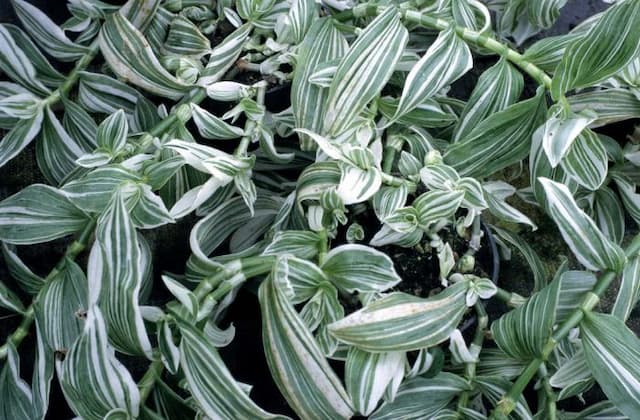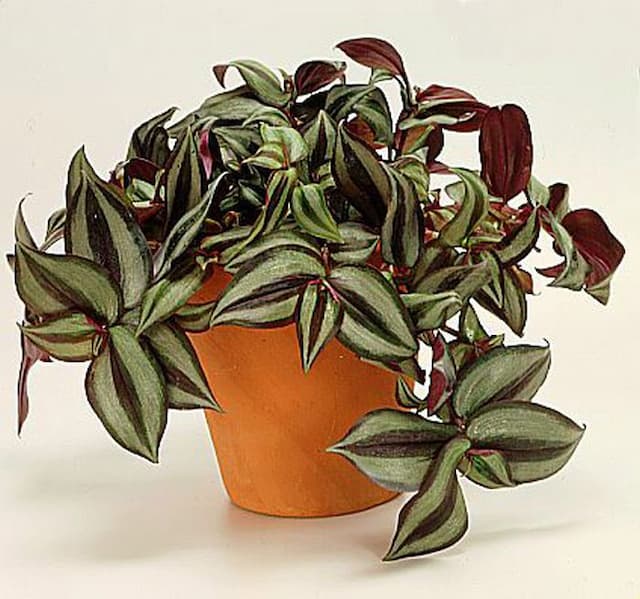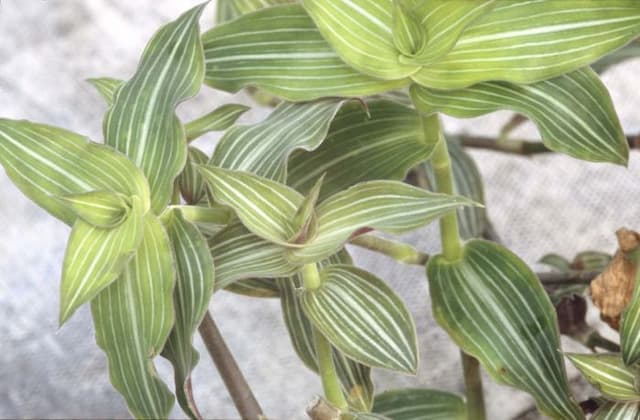Spiderwort Tradescantia (Andersoniana Group) 'Isis'

ABOUT
The Tradescantia 'Isis', commonly known as the Spiderwort, is a charming perennial plant that is admired for its attractive foliage and delightful blossoms. The leaves are long and narrow, presenting a luscious, grass-like appearance. They have a smooth texture and a rich, green color that forms an eye-catching backdrop for the flowers. The flowers themselves are a striking feature of this plant, usually blooming in a vivid shade of blue to purple. Each flower comprises three rounded petals that radiate outwards from the center, creating a symmetrical and balanced look. The center of the flower is often a contrasting hue, with bright yellow stamens that stand out against the colorful petals. These delicate blossoms are typically clustered at the tips of the stems, giving them a poised and elevated appearance that adds to the aesthetic appeal of the plant. The blooms of the Spiderwort tend to open in the morning and may close by afternoon, especially on hot days, providing a dynamic display that changes throughout the day. The flowering season is quite generous, extending from late spring into the summer months, offering a long period of visual interest. Overall, the Spiderwort 'Isis' is appreciated for its simple elegance and ability to bring a burst of color to garden spaces. Its dual charm of graceful foliage and bright, cheerful flowers makes it a beloved choice for borders, beds, and even container gardens.
About this plant
 Names
NamesFamily
Commelinaceae
Synonyms
Spiderwort, Spider Lily, Trinity Flower, Widow's Tears
Common names
Tradescantia x andersoniana 'Isis'.
 Toxicity
ToxicityTo humans
Spiderwort is generally considered non-toxic to humans. Therefore, ingesting parts of the plant typically should not lead to poisoning or severe adverse effects. However, it's advisable to avoid ingesting any plant material that is not explicitly deemed edible to prevent any potential stomach discomfort or allergic reactions.
To pets
Spiderwort is also non-toxic to pets such as dogs and cats. It is not known to cause poisoning in animals. Nonetheless, consumption of plant material can sometimes result in mild gastrointestinal upset in some pets; if symptoms were to appear, they might include vomiting and diarrhea. It's always best to monitor your pets and keep them from eating plants not intended for consumption.
 Characteristics
CharacteristicsLife cycle
Perennials
Foliage type
Deciduous
Color of leaves
Green
Flower color
Purple
Height
1-2 feet (30-60 cm)
Spread
1-2 feet (30-60 cm)
Plant type
Herb
Hardiness zones
4-9
Native area
North America
Benefits
 General Benefits
General Benefits- Easy to Grow: Tradescantia 'Isis' is known for its ease of care, making it suitable for both novice and experienced gardeners.
- Fast-Growing: This variety quickly fills spaces in the garden or landscape due to its vigorous growth habit.
- Drought Tolerant: Once established, it can withstand periods of low water, reducing the need for frequent irrigation.
- Attractive Foliage: Offers appealing green foliage that provides a lush backdrop for other plants in the garden.
- Long Blooming: Produces flowers for an extended period, often from early summer to the first frost, providing long-lasting visual interest.
- Pollinator Friendly: Flowers attract pollinators like bees and butterflies, contributing to the health of the local ecosystem.
- Groundcover: Can be used to cover bare spots in the garden, controlling weeds by outcompeting them for resources.
- Versatile: Suitable for a variety of garden settings, including borders, containers, and hanging baskets.
- Shade Tolerance: While preferring bright conditions, it can also tolerate partial shade, offering flexibility in garden placement.
- Winter Interest: Some Tradescantia varieties may retain their leaves in milder winters, providing color and texture during the colder months.
 Medical Properties
Medical PropertiesThis plant is not used for medical purposes.
 Air-purifying Qualities
Air-purifying QualitiesThis plant is not specifically known for air purifying qualities.
 Other Uses
Other Uses- Tradescantia can be used in mixed media or botanical art projects where the leaves and flowers provide unique textures and colors.
- The stems of Spiderwort are succulent and can be used in floral arrangements to add bulk and interesting foliage contrast.
- Spiderwort plants can be planted as a groundcover in large scale industrial landscaping where maintenance is minimal.
- The clear sap found in the stems has been traditionally used as a natural adhesive for small crafts or as a temporary binder for papers.
- Photographers sometimes use the vibrant flowers of Spiderwort to create stunning macro photography subjects.
- Leaves of the Spiderwort can be pressed and used to create natural patterns in plant-based dyes for fabrics.
- In hobbyist fishkeeping, the sturdy stems can be partially submerged in aquariums to create a semi-aquatic environment.
- Bioactive terrariums or vivariums for reptiles or amphibians can incorporate Spiderwort to mimic a natural ecosystem.
- As a teaching tool, Spiderwort's quick growth can be used in classrooms for experiments on phototropism or plant propagation.
- The color-changing property of Spiderwort flowers (due to pH changes) can serve as an engaging way to teach kids about plant biology and chemistry.
Interesting Facts
 Feng Shui
Feng ShuiThe Spiderwort is not used in Feng Shui practice.
 Zodiac Sign Compitability
Zodiac Sign CompitabilityThe Spiderwort is not used in astrology practice.
 Plant Symbolism
Plant Symbolism- Adaptability: Tradescantia, commonly known as Spiderwort, often symbolizes adaptability due to its hardy nature and ability to thrive in various conditions.
- Transient Beauty: The individual Spiderwort flowers often last for only one day, representing the transient but beautiful nature of life and moments.
- Survival: Its resilience and capacity to grow in tough environments make Spiderwort a symbol of survival and persistence.
- Purity: The bright, three-petaled flowers of the Spiderwort can symbolize purity and innocence.
- Boundaries: As Spiderwort can spread quickly if not managed, it can represent the need to set and respect boundaries in various aspects of life.
 Water
WaterSpiderwort needs to be watered regularly to maintain consistent moisture, especially during the growing season. It's best to water it deeply once a week, providing about one gallon per plant, depending on the size and the local climate. Always check the top inch of soil for dryness before watering. During the winter months, reduce watering frequency as the plant's growth slows down. Ensure good drainage to prevent waterlogging, which can lead to root rot.
 Light
LightSpiderwort thrives in bright, indirect sunlight but can also tolerate partial shade. The ideal spot for a Spiderwort would be in a location that receives morning sun and afternoon shade, protecting it from the intense heat of the day. Direct sunlight, especially in hot summer months, can scorch the leaves, so some protection, such as a sheer curtain, can be beneficial.
 Temperature
TemperatureSpiderwort prefers moderate temperatures and will grow best between 60 and 80 degrees Fahrenheit. They are hardy in a range of temperatures but should not be exposed to temperatures below 50 degrees Fahrenheit for extended periods as this can damage the plant. Protection from extreme cold and frost is necessary for the plant's survival.
 Pruning
PruningPrune Spiderwort to encourage bushier growth and to remove any dead or yellowing leaves. Lightly trimming the tips of the plant can stimulate new growth. Pruning is best done in the spring or early summer before the plant blooms. Deadheading, or removing spent flowers, can also promote a longer blooming period and prevent self-seeding, if not desired.
 Cleaning
CleaningAs needed
 Soil
SoilSpiderwort 'Isis' thrives in moist, well-draining soil with a pH of 5 to 6. A mix containing peat, perlite, and garden soil is ideal, ensuring adequate aeration and moisture retention.
 Repotting
RepottingSpiderwort 'Isis' typically requires repotting every 2 to 3 years or when it outgrows its current pot to maintain its health and encourage growth.
 Humidity & Misting
Humidity & MistingSpiderwort 'Isis' prefers a moderate humidity level, around 40-50%, which is typical of an indoor environment; misting can help if the air is too dry.
 Suitable locations
Suitable locationsIndoor
For Spiderwort 'Isis', ensure bright, indirect light and maintain room humidity.
Outdoor
Plant Spiderwort 'Isis' in part shade and keep soil consistently moist.
Hardiness zone
Spiderwort 'Isis' is suitable for USDA zones 4-9.
 Life cycle
Life cycleThe Spiderwort 'Isis' begins its life cycle as a seed that, once sown in well-draining soil and with adequate warmth, will germinate and grow into a young seedling. The seedling develops into a clump-forming perennial with lance-shaped leaves, undergoing vegetative growth where it puts out roots and foliage. During its active growth season, typically in spring to summer, it blossoms, producing tri-petaled flowers that are rich purplish-blue in color, which attract pollinators and may lead to seed formation if pollination occurs. Following the flowering stage, if seeds are produced, they mature and are eventually dispersed nearby or may be collected for propagation. As temperatures cool down in autumn, the plant may die back somewhat, but it is a hardy perennial and will resume growth from its root system once favorable conditions return in spring. With each successive year, clumps can become larger and may be divided for propagation or to control the plant's spread.
 Propogation
PropogationPropogation time
Spring to Summer
Propogation: The most popular method to propagate a Spiderwort, specifically the Tradescantia (Andersoniana Group) 'Isis', is by division. This is best done in the spring just as the new growth commences. To divide, carefully lift the plant from the soil and separate the clumps into smaller sections by either gently pulling apart the roots by hand or cutting them with a sharp knife. Ensure these divisions have a good amount of roots and at least a couple of shoots. Once divided, replant into potting soil and water thoroughly to settle the soil around the roots. Divisions should be planted at the same depth they were originally growing, and spaced around 12 inches (approximately 30 centimeters) apart to allow for adequate growing space. This method allows for quick establishment and a great way to expand the garden with more Spiderwort plants.



